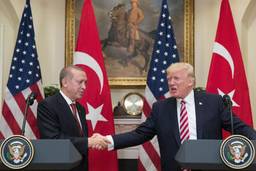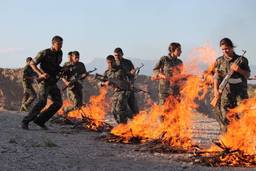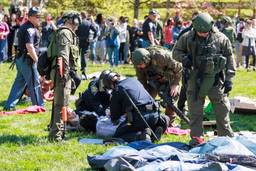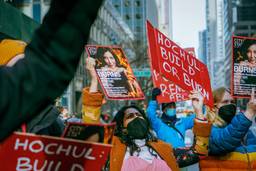The U.S. Betrayal of the Kurds Is Five Years in the Making
Though Trump struck the match, the latest crisis in Syria is the predictable result of long-standing U.S. policy.
Patrick Lewis
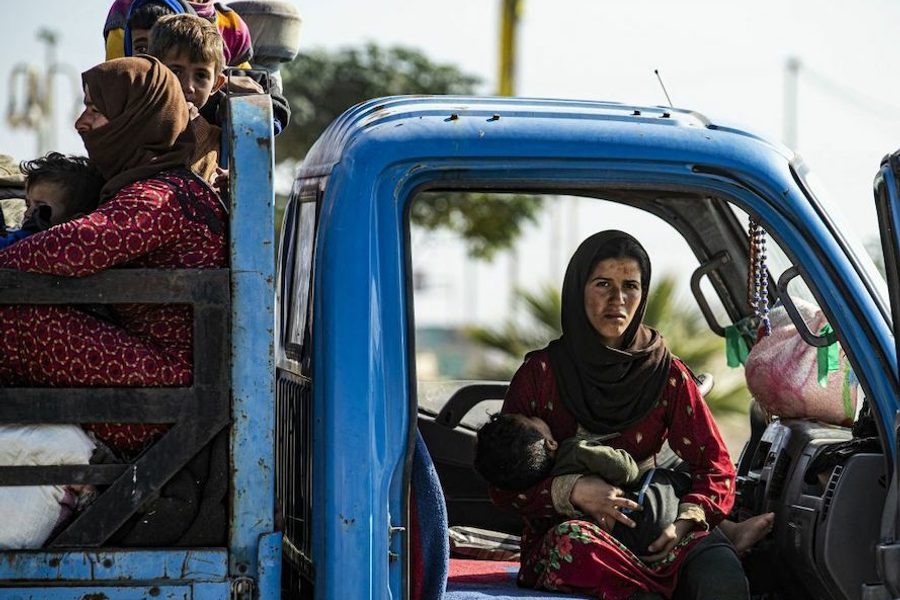
On October 9, Turkish forces opened a new front in the Syrian civil war with a cross-border offensive into northern Syria. The UN is reporting that more than 100,000 people have already fled their homes and Amnesty International is predicting a “humanitarian disaster” if the Turkish invasion continues.
World leaders have been right to condemn Turkey’s aggression. Particularly worrying was a pledge by Turkish president Erdogan before the UN General Assembly to forcibly relocate millions of Syrians refugees currently residing in Turkey to the areas “liberated” from Kurdish control. Local journalists have already detailed dozens of civilian deaths and injuries by Turkish shelling and airstrikes. And over the weekend, as Kurdish people and their allies took to the streets in an international day of solidarity for the people of Northern Syria, jihadist fighters attached to the Turkish-backed Free Syrian Army advanced south to the M4 highway, the primary east-west route through Northern Syria. After setting up a checkpoint, they began stopping civilian cars and executing civilians they suspected of links to Kurdish political parties. One such victim was Hevrin Khalaf, the general secretary of the Future Syria Party — a small, new party advocating pluralistic democracy and cooperation between Kurds and Arabs — who was dragged from her car and shot dead along with her driver.
In the United States, many politicians and media figures are blaming President Trump for the crisis, pointing to his role in allegedly “greenlighting” the Turkish operation, pulling U.S. soldiers from northern Syria. For its part, the Trump administration claims it did not approve the Turkish attacks, and that it strongly opposes them. But, administration officials contend, they were forced to pull back once Turkey made clear it wouldn’t be deterred from its attack; otherwise they would have been risking U.S soldiers’ lives.
There are many in Syria and Kurdistan, as well as in U.S. policy circles, who have found this argument unconvincing. Is it really possible, they ask, that Turkey would have risked direct military confrontation with the United States if the administration had stood firm? When pushed on their reasoning, some defenders of the administration have resorted to old clichés about ancient ethnic animosities, portraying the conflict as inevitable.
However, the conflict is not an issue of two peoples who cannot get along or have been “fighting for centuries.” Rather, it is the product of 100 years of state violence and colonialism. Turkey is home to roughly 15 million Kurds — the largest Kurdish population of any country — who were denied basic rights and freedoms, including the freedom to speak their own language, for most of the history of the Turkish Republic. Many of the Kurdish communities living along the Turkish border in Syria are descended from communities that fled Turkish state violence a century ago.
The United States, in recent years, had an opportunity to contribute to the resolution of this conflict. Instead, it has only fanned the flames. There is no question that Trump’s Syria policy, like his presidency more generally, has been feckless, clueless and cruel. But it also true that responsibility for the current crisis in Syria goes beyond Trump, and also lies with a wider failure on the part of the U.S. political establishment. Though it was ultimately Trump who struck the match, the smoldering powder-keg in northern Syria that could soon explode is a product of U.S. policy half-a-decade in the making.
Early Support for the Kurds in Syria
The current crisis comes five years to the month that the United States began military cooperation with the Kurdish YPG as a “partner” in its campaign against ISIS in Syria. Initially this partnership was an ad hoc arrangement that came together at another moment of crisis for U.S. credibility in the Middle East. Over the course of 2014, ISIS seized Raqqa (January); captured Mosul (June) and launched a genocidal attack against Sinjar (August). By early October 2014, ISIS forces had advanced even further, overrunning most of the Kobani canton — at the time a predominantly Kurdish enclave on the Turkish border — forcing hundreds of thousands of civilians to flee into Turkey and leaving its remaining, poorly-armed defenders pinned between the border and advancing ISIS fighters.
The Obama administration had already approved a limited U.S. air campaign against ISIS over Syria earlier that summer, but its response during the first weeks of the ISIS advance against Kobane had been tepid. At the time many commentators suggested this was out of deference to Turkey, whose political and military leaders saw the Kurdish enclaves that emerged along its border since 2012 as an imminent threat, and preferred (Kurdish leaders alleged) to see them destroyed.
But in early October, just as ISIS was expanding into Kobane, a series of urban uprisings shook Turkish Kurdistan, leaving dozens dead. Thousands of Kurds in Turkey also mobilized along the border with Kobani, while Kurdish diaspora communities launched nightly demonstrations on the streets of European cities. Ultimately, Turkey was pressured to open a corridor to allow Kurdish fighters and weapons to reach the city from Iraq.
Meanwhile, public opinion in the West, moved by the protests and already deeply alarmed by the rapid expansion of ISIS’s self-declared caliphate, quickly solidified around the need to defend Kobani. Only weeks before the 2014 midterm elections, and in plain view of the global news media, U.S. jets stepped up their attacks on ISIS targets in and around Kobani. By the end of October, the United States was coordinating its air strikes with the YPG and dropping weapons and ammunition directly to the city’s Kurdish and Arab defenders. In total, the battle for Kobani would last several months.
Soon, U.S., UK and French special forces were also working directly with YPG fighters, and by autumn 2015, YPG fighters had liberated most of the Kurdish-populated area of northern Syria from ISIS control, capturing the entire border region with Turkey east of the Euphrates.
A Two-Faced Strategy
For the YPG, these successes brought increased military aid and more public declarations of confidence from U.S. leaders, as well as a growing public admiration in the West more generally. However, these successes also further alarmed the Turkish state and strained its relationship with the United States and Europe.
U.S leaders could have sought to mediate between their new Kurdish partners and old NATO ally — but instead, they pursued a double game. Despite continued military support, they downplayed their relationship with Kurdish fighters, stressing that it was temporary and based on the necessity of combating ISIS (“our partners in the ongoing fight against ISIS” as they became known in Pentagon-speak). In a further attempt to placate Turkey, U.S. diplomats and top military officials publicly recommitted to a decades-old U.S. policy of military and diplomatic support for the Turkish state’s efforts to crush the PKK-led (and popularly supported) Kurdish movement in Turkey, despite the PKK’s historically close ties to America’s new Kurdish partners in Syria.
However, this approach did little to assuage Turkish concerns, and had immediate, severe and predictable consequences for the millions of Kurds living on both sides of the border. The first was that the YPG’s gains, coupled with the sinking popularity of the ruling government, fed existing tensions and mistrust within Turkey that precipitated the collapse of a two-year old peace process between Turkish state and the PKK in 2015. This in turn led to destructive fighting in urban centers of Turkish Kurdistan that left hundreds dead and displaced thousands more. The second was to draw Turkish soldiers directly into Syria. In 2016, After U.S.-backed Kurdish fighters successfully captured Manbij from ISIS, near the Turkish border, the Turkish army launched its first cross-border offensive that August. Ostensibly the target was the ISIS-controlled cities of Jarabulus and Al-Bab, but it was widely acknowledged that the real objective was to prevent further advances by Kurdish fighters. Turkey soldiers continue to occupy the region.
In May 2017, as Kurdish fighters encircled the ISIS capital of Raqqa, Turkish fighters bombed Kurdish positions near U.S. soldiers and publicly threatened an invasion to thwart the growing US-Kurdish partnership. The following January, Turkish forces again crossed the border into Syria in an operation euphemistically named “Olive Branch.” This time they targeted Kurdish autonomy in Syria directly, attacking a relatively peaceful enclave called Afrin following the withdrawal of Russian soldiers. Over a period of about a month, Turkish soldiers and their jihadist allies overran the enclave, driving tens of thousands from their homes and resettling the region with jihadist fighters and their families. At the time U.S. officials expressed concern about Turkish actions and called for restraint, but stressed that they did not operate in northwestern Syria (and therefore were not responsible). Today, Afrin also remains under Turkish occupation.
Over the past half-decade Kurdish and Arab fighters of the Syrian Democratic Forces (SDF) — a larger coalition of opposition fighters that has formed around the YPG — backed by U.S. air power liberated all of eastern Syria from ISIS. More than 10,000 SDF fighters were killed in these campaigns. Yet at no point did the United States or any of its Western military allies in Syria (U.K., France, Canada) taken any steps to recognize the legitimacy of their “partners” beyond their role as “boots on the ground.” Nor did they grant any official status or direct aid to the autonomous councils that now administer these liberated territories. In fact, both U.S. military and State Department officials publicly stated U.S. opposition to any form of federalism in Syria — in effect, meaning the U.S. government would not recognize any autonomous structure set up by the Kurds within Syria. Given the United States’ simultaneous hostility toward and grudging acceptance of the Assad regime in Damascus, this raises the question of exactly what their plan for a post-conflict Syria looked like. Perhaps now we know; or, more likely, perhaps they never had one.
Absent any form of political recognition for the Autonomous Administration of North and East Syria (NES) by the United States and its Western allies in political consultation with Turkey, it was always difficult to imagine how a serious peace process could move forward. Looking at the situation today, it appears that the United States, having abandoned its only local “partners” and any real stake in the conflict, is unlikely to play a major role in any future settlement. So far, Turkey’s leaders have publicly dismissed calls by the U.S. and its European allies to halt its offensive, threatening to limit cooperation with the European Union and even deliberately targeted a U.S. special forces base on Friday with artillery fire, according to Pentagon officials (although Turkey has denied this).
Meanwhile, the SDF has openly called for support from the Assad regime to defend itself from Turkey — something it had long said it would do if it was left to fight Turkey by itself. By Sunday evening, Kurdish officials claimed to have reached a memorandum of understanding with the Assad regime and Russia to allow Syrian soldiers to move toward border regions with Turkey currently under SDF control. “We know that we would have to make painful compromises with Moscow and Bashar al-Assad if we go down the road of working with them,” the commander of the SDF wrote in a letter published Sunday in Foreign Policy, “but if we have to choose between compromises and the genocide of our people, we will surely choose life for our people.” Soon after the agreement was made public, U.S. troops were reported preventing Syrian troops from entering territory under SDF control. Almost simultaneously, the administration announced it was pulling all U.S. troops from Northern Syria.
Fighting between Turkey, its allies and the SDF could quickly escalate into a larger conflict between Turkey and the Syrian regime. As of Monday evening regime fighters and Turkish-backed forces were already exchanging fire around the cities of Manbij and Ayn Isa. If rapid de-escalation is not achieved, such clashes are likely to grow in number over the coming days and weeks.
To prevent catastrophe in Northern Syria requires an all-out diplomatic effort coupled with sustained international pressure to convince Turkey to halt its offensive in Syria and to establish a ceasefire encompassing all parties. France and Germany have already called for limiting arms exports to Turkey. The response by the Trump administration so far has been less forceful. As of Monday evening, the administration line remained that all U.S. troops will be coming out of Syria. But already a bipartisan effort in congress is moving to block the withdrawal. Right now it appears that U.S. soldiers are still at bases as far Northeast as Kobane and as far South as Deiz ez-Zor, even as the Syrian regime released an agreement with the SDF to move their own forces into these regions.
On Monday, Vice President Pence called for direct negotiations between the Kurdish SDF and the Turkish government about political settlement for Syria and he announced that he would personally lead a delegation to Turkey “as soon as possible” to oversee the process. Absent from Pence’s statement was an explanation of why no such initiative was undertaken sooner. The U.S. had a half-decade to bring Turkey and Kurdish political actors in Turkey, Syria and Iraq to a common bargaining table and it failed. Such a process would no doubt have been difficult, especially given the Turkish state’s entrenched anti-Kurdish phobia, but was it inconceivable? And if such a process is necessary now, why wasn’t it attempted two, three or five years ago, when the U.S. was in a much stronger position to mediate? It seems that a just solution was simply never a priority.
The Trump’s administration’s disastrous handling of events over the past week has certainly made the situation in Syria more dangerous. But looking beyond the incompetence and hubris of the Trump administration, we see that this crisis is the also the predictable consequence of a half-decade of cynical establishment foreign policy, and its disregard for the rights and lives of the people over whom Washington’s power is exercised.
